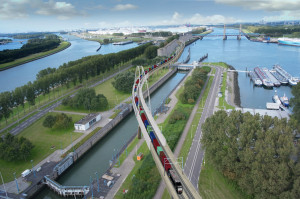Port of Rotterdam Authority to redirect 4km of port section of Betuwe Route
 The Port of Rotterdam Authority is going to redirect approximately 4km of the port (or first) section of the Betuwe Route. As a result, the railway line will no longer run over the Caland Bridge, so that shipping and rail traffic will cease to get in each other’s way from 2020 onwards. It will also bring an end to all the noise nuisance caused by the rail track near the village of Rozenburg. Construction of the new route will cost around EUR 275 million. The Ministry of Infrastructure and the Environment is contributing over EUR 100 million, the European Union EUR 62 million and the Port Authority the remainder. That is close on €100 million. The Port Authority will construct the new route and then hand the railway line over to ProRail.
The Port of Rotterdam Authority is going to redirect approximately 4km of the port (or first) section of the Betuwe Route. As a result, the railway line will no longer run over the Caland Bridge, so that shipping and rail traffic will cease to get in each other’s way from 2020 onwards. It will also bring an end to all the noise nuisance caused by the rail track near the village of Rozenburg. Construction of the new route will cost around EUR 275 million. The Ministry of Infrastructure and the Environment is contributing over EUR 100 million, the European Union EUR 62 million and the Port Authority the remainder. That is close on €100 million. The Port Authority will construct the new route and then hand the railway line over to ProRail.
Splitting traffic flows
The Caland Bridge near Rozenburg is a steel vertical lift bridge that will reach the end of its technical lifespan in 2020. The bridge is an important traffic hub, used by rail and road traffic. By redirecting the railway line over the Rozenburgse Sluis and via Theemsweg, the increasing rail traffic to and from Europoort and the Maasvlakte will no longer be obstructed by shipping. This will considerably improve the flow of traffic.
Project organisation for Theemsweg Route
COO of the Port of Rotterdam Authority, Ronald Paul, on the investment in the Theemsweg Route: “The connections to the hinterland are essential for the port’s competitive position. That’s why we want to see a solution to the capacity problem. But because the Government doesn’t have sufficient funds to do this in the coming years, we suggested to the Ministry of Infrastructure and the Environment that we, as Port Authority, would pay a large proportion of the costs for the Theemsweg Route and execute the project ourselves. On completion, we will hand the new stretch of track over to ProRail. The ministry responded positively to our proposal. We will produce the final design for the railway line in collaboration with ProRail. The new route will be approximately 4km long and run over a raised railway viaduct. The track will have two arched bridges and link up again with the existing track where it meets the A15.”
No equal playing field
It is very unusual in Europe for a port authority to invest as heavily in public infrastructure as is currently the case in Rotterdam. In Hamburg, Wilhelmshaven, Bremerhaven, Antwerp and Zeebrugge, the authorities not only pay for the public infrastructure such as railways, but also contribute towards investments in the development of ports, or the government settles the losses suffered by the port authorities. This was revealed by the study ‘Level playing field’ (2014), conducted by RHV-Erasmus University and Ecorys, by order of the Ministry of Infrastructure and the Environment. As a result, clients of these ports do not pay a realistic price, there is no equal playing field and the Dutch ports lose out on cargo, work and revenue. The researchers calculated that Rotterdam lost out on about one million TEU containers a year, as just one example, due to this unfair competition. As the Port of Rotterdam Authority makes a substantial contribution to public infrastructure, the situation here is the precise opposite of that in many other European ports.






